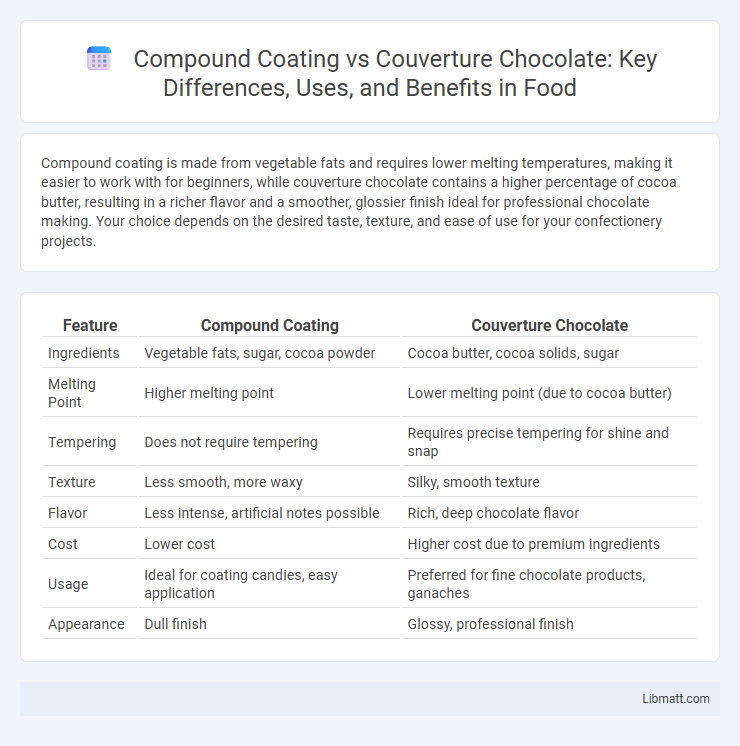Compound coating is made from vegetable fats and requires lower melting temperatures, making it easier to work with for beginners, while couverture chocolate contains a higher percentage of cocoa butter, resulting in a richer flavor and a smoother, glossier finish ideal for professional chocolate making. Your choice depends on the desired taste, texture, and ease of use for your confectionery projects.
Table of Comparison
| Feature | Compound Coating | Couverture Chocolate |
|---|---|---|
| Ingredients | Vegetable fats, sugar, cocoa powder | Cocoa butter, cocoa solids, sugar |
| Melting Point | Higher melting point | Lower melting point (due to cocoa butter) |
| Tempering | Does not require tempering | Requires precise tempering for shine and snap |
| Texture | Less smooth, more waxy | Silky, smooth texture |
| Flavor | Less intense, artificial notes possible | Rich, deep chocolate flavor |
| Cost | Lower cost | Higher cost due to premium ingredients |
| Usage | Ideal for coating candies, easy application | Preferred for fine chocolate products, ganaches |
| Appearance | Dull finish | Glossy, professional finish |
Understanding Compound Coating and Couverture Chocolate
Compound coating, made from vegetable fats instead of cocoa butter, offers easier melting and setting properties ideal for cost-effective confections and candy coatings. Couverture chocolate contains a high percentage of cocoa butter, providing superior gloss, texture, and flavor, making it preferred for fine chocolate making and professional use. Understanding the differences in fat composition and melting behavior is crucial for selecting the right product for specific culinary applications.
Key Differences Between Compound and Couverture Chocolate
Compound chocolate uses vegetable fats instead of cocoa butter, making it more affordable and easier to handle during melting and shaping processes. Couverture chocolate contains a higher percentage of cocoa butter, resulting in superior texture, glossy finish, and richer flavor preferred by professional chocolatiers. The key difference lies in composition and performance: compound chocolate is ideal for budget-friendly confectionery with less tempering sensitivity, while couverture chocolate demands tempering to achieve its characteristic snap and sheen.
Ingredients Breakdown: What’s Inside Each Type?
Compound coating contains vegetable fats like palm oil instead of cocoa butter, along with sugar, cocoa powder, and emulsifiers, making it more affordable and easier to work with at room temperature. Couverture chocolate features a higher percentage of cocoa butter, pure cocoa solids, and sugar, providing a richer flavor and smoother texture ideal for tempering and professional confectionery. Understanding these ingredient differences helps you choose the best option for your specific baking or coating needs.
Melting and Tempering Requirements
Compound chocolate requires lower melting temperatures around 45-50degC and does not require tempering, making it easier to work with for coatings and molds. Couverture chocolate must be tempered through precise temperature control--typically heated to 45degC, cooled to 27degC, then reheated to 31-32degC--to develop a glossy finish and snap. Proper tempering stabilizes cocoa butter crystals in couverture chocolate, ensuring optimal texture and appearance.
Taste and Texture Comparison
Compound coating offers a sweeter, less intense cocoa flavor with a waxier texture compared to couverture chocolate, which provides a richer, more complex taste due to its higher cocoa butter content. Couverture chocolate melts smoothly on the palate, delivering a creamy mouthfeel, while compound coating tends to have a firmer snap and slight waxiness from vegetable fats. The superior cocoa butter in couverture enhances flavor release and texture, making it preferred for gourmet applications, whereas compound coating suits cost-effective, easy-to-handle confectionery products.
Applications in Baking and Confectionery
Compound coating offers versatility in baking and confectionery with easier melting and setting, making it ideal for coatings, enrobing, and candy molding without tempering requirements. Couverture chocolate, prized for its high cocoa butter content, delivers superior gloss, snap, and flavor, essential for professional chocolates and delicate decorations. Your choice depends on the desired texture, appearance, and ease of use in creating premium baked goods or confectionery treats.
Cost and Availability Considerations
Compound coating costs significantly less than couverture chocolate due to its use of vegetable fats instead of cocoa butter, making it more budget-friendly for large-scale baking and confectionery production. It is widely available in various retail and foodservice outlets, ensuring easy access for both amateurs and professionals. Couverture chocolate, priced higher due to its purity and quality, is often found in specialty stores and requires careful sourcing for consistent supply.
Shelf Life and Storage
Compound chocolate offers a longer shelf life of up to 12 months due to its use of vegetable fats that resist oxidation and moisture better than the cocoa butter in couverture chocolate. Couverture chocolate requires storage at a consistent temperature between 15-18degC with 50-60% humidity to prevent blooming and maintain quality, typically lasting about 6 to 9 months. Proper airtight packaging extends the freshness of both, but couverture demands more precise storage conditions to preserve its superior flavor and texture.
Nutritional Profiles Compared
Compound coating contains vegetable fats and often has a lower cocoa butter content than couverture chocolate, resulting in a higher saturated fat level and fewer antioxidants. Couverture chocolate, made with a higher percentage of cocoa butter and real cocoa solids, typically offers better nutritional value, including more flavonoids and minerals like magnesium. Your choice between the two may impact health benefits, especially if you prioritize antioxidant intake and natural ingredients.
Choosing the Right Chocolate for Your Needs
Compound coating contains vegetable fats instead of cocoa butter, making it easier to melt and mold, ideal for candy making and budget-conscious projects. Couverture chocolate has a high cocoa butter content, providing superior texture and glossy finish, preferred by professional chocolatiers for tempering and fine confectionery. Selecting the right chocolate depends on the desired flavor, texture, and application, with compound coating suited for convenience and couverture for premium quality.
compound coating vs couverture chocolate Infographic

 libmatt.com
libmatt.com